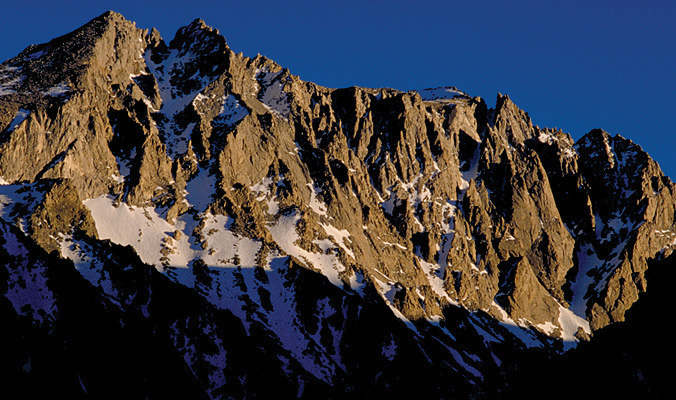Anyone who has driven south from Bishop on California’s scenic Route 395 in the spring has seen it, a thin white line dropping from the right corner of Mt. Williamson’s north face. To skiers of the steep, that thread beckons like a hypodermic needle loaded with raw adrenaline.
The first time I noticed it, I couldn’t help but think that it wasn’t a continuous shot. From the road, on the north side of Independence, the line looks dead vertical, an illusion of foreshortening. Even as a neophyte Sierra skier I knew that, if it held snow, it would be skiable. As to whether it was a plumb line, Dave Braun found out, many years after it first caught my eye, that it isn’t.
Without even considering its north face, Mt. Williamson is an imposing mountain for skiers. Says Marty Hornick, a ranger of 37 years in the Whitney district and a regular skier of Williamson’s slopes, “Nothing else compares to it.”

Giant’s Steps on 14,370-foot Mt. Williamson. [Photo] Craig Dostie
Williamson’s is the Eastside’s largest massif, rising from 6,000 feet on the east to 14,370 feet on the west and encompassing all the mass between George Creek to the south and Williamson Creek to the north. With no established trails, access is a catch-22 of dense underbrush choking the natural routes up George, Bairs and North Bairs Creeks, making passage with skis a gauntlet of frustration.
The thought of skiing anything on the north wall of Williamson probably didn’t occur with any measure of regularity until the ’80s. While occasional early tours traversed Williamson’s flanks, they were infrequent and definitely didn’t reach the north side. Los Angeles’s Ski Mountaineers Section of the Sierra Club led semi-regular ski tours on Mt. Williamson and, in the late ’70s, Galen Rowell and Kim Schmitz skied the south side on skinny skis, pins and leather boots; Schmitz’s arm was even in a cast.
Soon after Dave Beck established the now classic Sierra High Route in 1975, Tom Carter, Allan Bard and Chris Cox pioneered the Redline traverse, logging descents along the Sierra Crest that were alpine in nature and Nordic in execution. In the same decade, Bela and Mimi Vadasz began incorporating as much of the holistic, European mountain attitude as they dared in their Sierra-based guiding program, Alpine Skills International. Before the ’80s were over, the capability of telemark gear had been proven on descents of the U- and V-Notch under North Palisade peak, Mt. Whitney’s Mountaineers Route and Sierra classics like the Bloody and Dana Couloirs.
While people like Bard, Carter and Bela Vadasz were proving it was possible to pull off such descents on freeheel gear, some behind the scenes were tinkering with plastic telemark boots that might expand such feats from the athletically gifted to the athletically inclined. Interest in backcountry skiing exploded in the ’90s, in part due to the enthusiasm created by plastic telemark boots.

Dave Braun hopping into the third of the Giant’s Steps in June 1998 on Mt. Williamson. “Braun agreed to do a ‘rerun’ for photos,” Craig Dostie says. “I believe I did the second descent on tele gear and arguably the only tele turns ever made in the Giant’s Steps.” But, as is the case today, no one cares if you tele. [Photo] Craig Dostie
When Dave Braun made the first descent of the Giant’s Steps couloir over Memorial Day weekend 1998, he wore SCARPA’s plastic T2 telemark boot. The improvement in gear was part of the equation. The more critical part was figuring the route out.
Besides skiing all of California’s 14ers, John Morrison has returned to Giant’s Steps three times, two shy of Braun’s five descents. And everyone I’ve spoken with agrees with Morrison’s assessment. “It really hit me after skiing it last year—it’s three couloirs in one,” he says. “Each one has an end, but they connect. It makes you wonder, ‘How did that happen?’ It’s long and beautiful and aesthetic and totally unique.”
“There’s no other descent like it, but the crux is knowing where the entrance is,” Tahoe-based guide Brennan Lagasse said after skiing Giant’s Steps with my cousin, Jeff Dostie. “You have to keep something in reserve, because the first two [steps] cliff out, and you can’t see the whole line. Each step is hidden from the next.”
Dave Braun’s first descent required four trips over a six-week period to piece the puzzle together, starting out at the Shepherd Pass trailhead and studying it from the ridge between Symmes and Shepherd Creeks, then the ridge forming Williamson Creek’s north boundary, plus a direct attempt from the bottom of the face in Williamson Creek.
Now that the route’s entrance is known, the Giant’s Steps is commonly done as an exhausting, single-day, 8,000-vertical-foot loop starting with a bushwhack in lower Bairs Creek, up the eastern slopes to the summit, then diagonally down the north face to Williamson Creek and back out to sagebrush on the desert floor.
The thought of skiing such lines did not occur to the average American skier until Chris Landry’s out-of-context definition of extreme skiing took root, wherein “…if you fall, you die.” The Giant’s Steps certainly offers that possibility: the route’s first two pitches end by flushing over granite into space. Just before they cliff out, however, the snow ramps up on skier’s right into a frozen wave—sometimes corniced, sometimes just a hump of snow—that connects that step’s bottom to the top of the next.
Doug Robinson, who has spent a lifetime climbing, skiing and documenting life in the Sierra Nevada, believes the Giant’s Steps has the classic signs of mountaineering quality. “It requires you to think, to circumvent conditions,” he says. “And when you’re done, you know you’ve earned it.”










It is an epic trip! Not to be taken lightly but so perfectly laid across a massive beautiful face it begs for attention. One of the best moments I have ever had in the mountains.
https://instagram.com/p/BQjmZe7B-T-/
https://instagram.com/p/BVBMqt9jJUx/